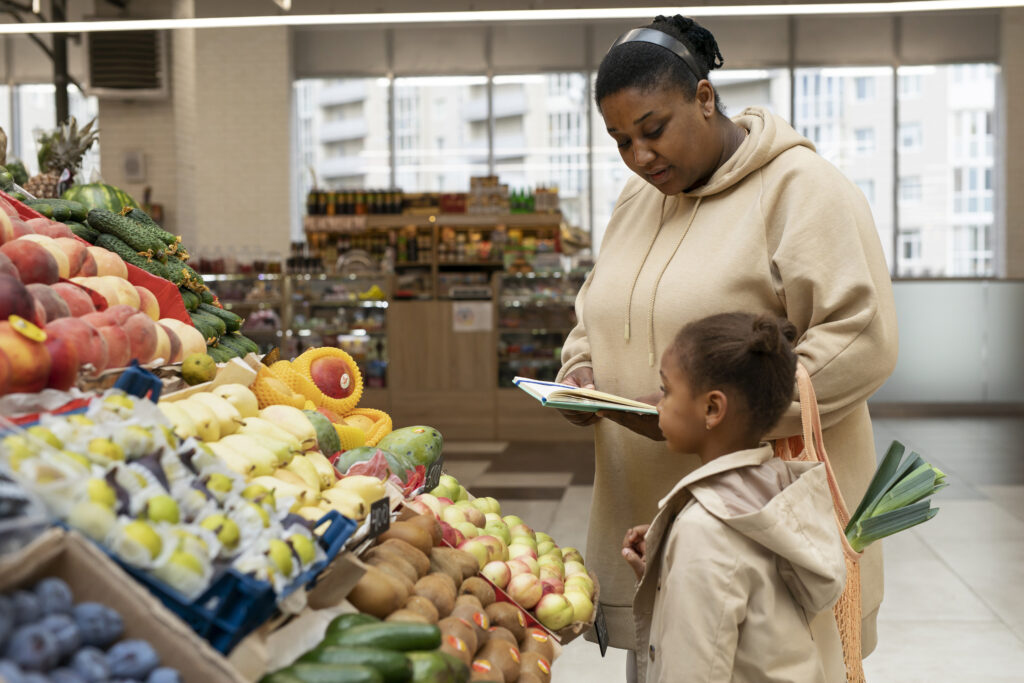
August is Kids Eat Right Month, the Academy of Nutrition and Dietetics’ annual campaign. Its purpose is to celebrate the importance of healthful eating and active lifestyles for children and their families. Healthy eating can only happen when healthy food is available. And that means grocery shopping—sometimes with children in tow.
Grocery Stores as “Learning Labs”
I have lived through many a trip to the supermarket with my own two kids. So I know it can be inconvenient and more time-consuming than it would be without them. But there is value in bringing grade-school-aged children through the aisles with you. The physical space and hands-on environment of the store can act as a learning lab for kids. With plenty of opportunities to teach them about food and nutrition, shopping can feel more like a field trip than a boring chore.
Children are more likely to try new foods when they’re involved in planning and preparing nutritious meals (with age-appropriate tasks). Children are more likely to try new foods when they’re involved in planning and preparing nutritious meals (with age-appropriate tasks). They will also have a greater understanding of nutritious, healthful foods that will benefit them for a lifetime. Luckily, there are plenty of ways to create simple food and nutrition lessons for kids in the store environment.
Before you go shopping, review the store flyer (online or via mail) with your child. Discuss which items you’ll be looking for, and make a grocery list together. When you get to the market, there are many food- and nutrition-related topics you can talk about, including:
- How different fruits and vegetables grow (underground, on a bush or tree, or inside a shell, like nuts)
- How food gets to the supermarket
- Which foods belong to which food groups
- The wide variety within certain food groups (fruits and veggies, dried beans, grains)
- How to compare Guiding Stars ratings for products using shelf tags and labels
- How to check prices on shelf tags and signage
- For older kids, how to understand unit pricing using shelf tags
Fun Tasks for Young Shoppers
If shopping doesn’t feel fun, your little “helpers” won’t want to go along. Granted, there may be occasions when your child hops up the minute you mention going to the market. In those cases, there’s a good chance they simply want to ask for a specific item. (“Pester power” can be strong, but you can resist!) And the promise of helping you make food selections (“red or green grapes today?”) may be enough for a toddler. But older children need to feel like they are actually helping and contributing. Therefore, it’s handy to have some child-appropriate shopping tasks in mind ahead of time. For the youngest children, aim to keep shopping trips short. And keep in mind that supervision is important for all children—the store is a public place, after all. The idea is to teach shopping skills, nutrition information, and appropriate behavior within the market.
Here are a few ideas to get you started…
For Preschool-Aged Kids
Making shopping into a game is the idea with this age group. Along the way, chat about nutrition in a low-key way.
Hunt for Stars: Ask your child to help you find items within a food category that earn Guiding Stars. Then allow them to choose which one to put in the cart.
Color of the Day: Have your child point out all the fruits and veggies of a specific color in the produce department. (Purple was always my favorite, since I knew there were just enough, but not too many types of purple produce.)
Size Smart: Ask your child to help you pick out the biggest watermelon or the longest zucchini.
New Food Day: Let your child pick out a new food to try. Mix it up by suggesting a new store aisle each time. They can choose a new type of bread, a new kind of canned bean, or a new flavor of yogurt.
Recipe Ready: Peruse the star-earning recipes on Guidingstars.com and select one you want to prepare with your child’s help. Then shop for the required ingredients and cook together. For more on cooking with kids, read this post and this one.
For Grade School-Aged Kids
Practicing reading and math skills, as well as teaching basic shopping skills, helps older kids feel useful in the store. Here are several ways they can be productive shoppers-in-training:
- Write out the list at home
- Locate and select specific items in the aisle where you’re shopping
- Check dates on dairy products before putting them in the cart
- Politely ask a store associate where an item is located
- Help pick out ripe fruit by smelling, gently handling, etc.
- Review your list and say which items likely appear in the aisle where you’re currently shopping
- Compare item price to unit price to find the best value
- Check ingredient lists (especially if someone has a food allergy or intolerance)
- Compare food labels of similar products, such as yogurts (ask them which has the least added sugar or most fiber)
- Put items on the conveyor belt or scan items at the self-checkout
- Bag groceries in a logical way that also prevents damage